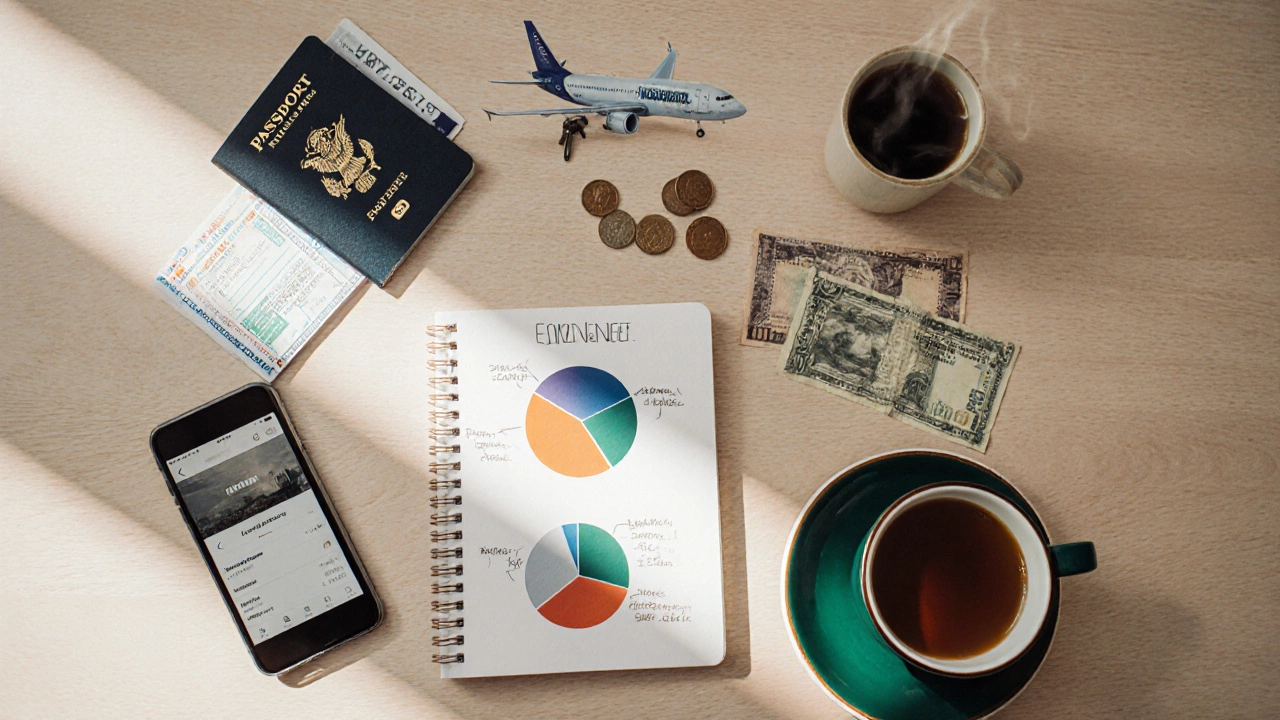Weekend Getaway Budget Calculator
Calculate if your $500 weekend trip plan stays within budget. Input your estimated costs for transport, lodging, food, and activities to see if you stay under the $500 limit.
Ever stared at your bank account and wondered if $500 can actually fund a two‑day escape? You’re not alone. A lot of people think you need a big budget for a weekend break, but with a bit of planning you can stretch that half‑thousand dollars pretty far. Below we break down where the money goes, which Indian destinations give the most bang for your buck, and the hacks that let you travel without breaking the bank.
Understanding What $500 Can Really Cover
First, let’s set a realistic baseline. Weekend trip budget of $500 typically has to cover four major buckets: transport, lodging, food & drinks, and incidentals (activities, insurance, small fees). If you’re flexible about travel dates, choose off‑peak days, and stay in budget‑friendly spots, the numbers start to line up.
Here’s a quick rule of thumb for a typical Indian weekend trip:
- Transportation: 30-40% of the total (≈ $150‑$200)
- Accommodation: 25-35% (≈ $125‑$175)
- Food & drinks: 20-25% (≈ $100‑$125)
- Activities & misc.: 10-15% (≈ $50‑$75)
That adds up nicely to $500. The magic lies in squeezing each line item, which we explore next.
Breaking Down the Cost Categories
Below you’ll find the typical price ranges for each category when you choose a budget‑focused approach.
- Transport: Low‑cost airlines (IndiGo, SpiceJet) on a Saturday‑Monday round‑trip can be $60‑$100 if you book 2‑3 weeks ahead. For destinations reachable by train, a 2‑class AC ticket on popular routes runs $30‑$70. Buses and shared cabs add $10‑$30.
- Lodging: Hostels, budget hotels, or homestays range $15‑$30 per night. Platforms like OYO and Zostel frequently run flash sales that drop a room to $12‑$18.
- Food & drinks: Street eats, thali meals, and local cafés keep the per‑meal cost at $3‑$7. A couple of splurge dinners at mid‑range restaurants (₹1,200‑₹1,500) still fit the budget if you keep other meals cheap.
- Activities & misc.: Entry fees for parks, museums, or adventure sports usually cost $5‑$15. A modest travel insurance plan for two days is $5‑$10. Add a bit of buffer for taxis or unexpected tips.
Sample Itineraries That Stay Under $500
| Destination | Transport | Accommodation (2 nights) | Food & Drinks | Activities & Misc. | Total |
|---|---|---|---|---|---|
| Manali (Himachal) | $130 (budget flight + airport‑to‑city taxi) | $70 (hostel dorm) | $100 (local dhaba + café) | $80 (solang‑valley entry, bike‑rent) | $480 |
| Rishikesh (Uttarakhand) | $70 (train AC 2‑tier) | $60 (budget guesthouse) | $90 (vegetarian meals) | $70 (white‑water rafting, ashram visit) | $290 |
| Goa (West Coast) | $150 (low‑cost airline) | $80 (hostel near beach) | $120 (sea‑food shacks, market stalls) | $100 (beach activities, sunset cruise) | $450 |
All three trips sit comfortably under the $500 mark, but notice the variation. Rishikesh is the cheapest because transport and activities are low‑cost, whereas Manali and Goa push the limit with flights and extra activities.

Money‑Saving Hacks You Can Apply Anywhere
Even if your chosen destination isn’t in the table, these tricks keep the bill low.
- Book transport early: Flights and train tickets drop sharply 2‑3 weeks before departure. Set price alerts on apps like MakeMyTrip.
- Use travel‑specific credit cards: Many Indian cards give 2‑5% cashback on travel spend, effectively shaving $10‑$25 off the total.
- Leverage loyalty programs: Stay 2+ nights at the same budget chain and you might earn a free night credit.
- Eat where locals eat: Avoid tourist‑centric restaurants; street food stalls and local messes serve a satisfying meal for $2‑$4.
- Travel light: Avoid extra baggage fees on low‑cost carriers by packing a carry‑on only.
- Combine activities: Look for combo tickets (e.g., entry + rafting) that offer 15‑20% discount.
Quick Planning Checklist (Print‑Friendly)
- Decide on a destination that’s ≤ 2‑3 hours by flight or ≤ 6‑8 hours by train/bus.
- Set a max spend per category (see the 30‑40‑20‑10 rule).
- Book transport 2‑3 weeks in advance; lock in a cheap fare.
- Reserve accommodation through platforms offering “free cancellation” to stay flexible.
- Plan 2‑3 activities that cost ≤ $20 each; prioritize free attractions (parks, beaches).
- Download a budgeting app (e.g., Trail Wallet) and log every expense in real time.
- Buy travel insurance that covers medical emergencies up to $5,000 for $5‑$10.

When 0 Might Not Be Enough
If you’re eyeing premium experiences-like a 4‑star resort in Goa, a private yacht cruise, or a guided trekking expedition in the Himalayas-the $500 limit quickly evaporates. Luxury stays alone can run $100‑$150 per night, blowing the lodging budget. Similarly, peak‑season flights (e.g., December holidays) often cost double the off‑peak rates.
In those cases, either:
- Raise the budget by $150‑$200 to accommodate the upgrade, or
- Trim other categories (skip a paid activity, opt for a shared room) to keep the overall spend near $500.
Being honest about what matters to you helps you allocate the limited funds where they count most.
Mini‑FAQ - Your $500 Weekend Questions Answered
Can I travel on $500 if I’m flying from Delhi?
Yes, if you pick a budget airline, travel during a weekday‑evening departure, and stay in hostels. For example, a round‑trip to Jaipur costs about $80, leaving $420 for the rest of the trip.
What’s the cheapest way to move around a city during a weekend?
Public transport passes are the most wallet‑friendly. In metros like Delhi or Mumbai, a two‑day metro card costs under $5. For smaller towns, auto‑rickshaws or bike‑share programs charge $0.30‑$0.50 per km.
Do I need travel insurance for a $500 weekend?
While not mandatory, a basic $5‑$10 policy covers medical emergencies and lost baggage. It’s a small price to pay for peace of mind, especially if you’re doing adventure activities.
Can I still have a romantic weekend on $500?
Absolutely. Choose a scenic spot like Rishikesh, stay in a riverside guesthouse (~$30/night), enjoy candlelight dinner at a local dhaba, and add a shared sunset boat ride. The total stays well under $500.
What’s the best budgeting app for short trips?
Trail Wallet, Splitwise, and the built‑in “Expense Tracker” in Google Pay all let you categorize spend in real time. They sync across devices, so you always know where your $500 is going.
Bottom line: $500 can fund a fun, memorable weekend if you plan smartly, pick the right destination, and keep an eye on each expense category. Start with the checklist, pick a spot from the table, and you’ll be on your way to a budget‑friendly escape without breaking the bank.


